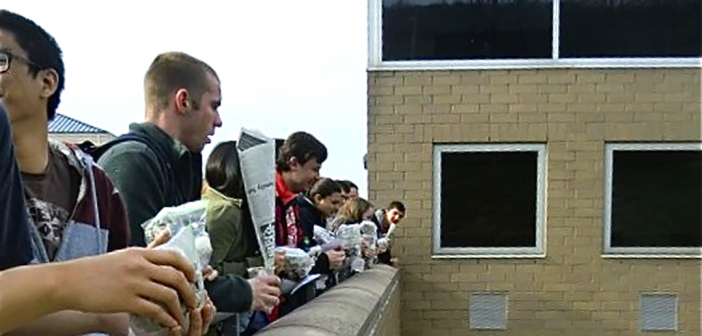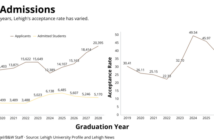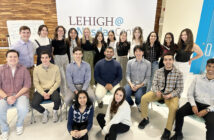The National Society for Black Engineers, Society of Hispanic Engineers and Society of Women Engineers planned an egg drop competition at Rauch Business Center on April 18 to bring the Lehigh community together with a fun activity.
The prize for the first-place team was $250 and $100 for the second-place team. About 35 teams participated in the event.
All competitors were asked to build a device to keep a chicken egg intact when dropped from three different heights using materials provided by the hosting organizations. To make the task more challenging, each team was required to use an imaginary maximum budget of $14.
The teams were provided with different priced building items to make their design. The material options included plastic cups, newspaper sheets, sandwich bags, popsicle sticks, rubber bands, string, cotton balls, marshmallows and masking tape.
“This is the first egg drop competition opened to the campus,” said Geordan Johnson, ’15, the president of the National Society for Black Engineers. “SWE does an egg drop competition for middle school students, and ideas were taken from their competition. The egg drop competition is a fun experience in bringing the school closer together.”
Students from various majors gathered in Perella Auditorium to demonstrate their creativity in designing their device to support the egg. Students were not informed about the materials prior to the event and had 30 minutes to buy the materials as well as construct and execute their design.
One team in the event included Katherine Fletcher, ’16; Liz Hutnikoff, ’15; Jordan Greer, ’16; and Shannon Varcoe, ’15. The team members combined their skills to build their egg contraption.
After four failed attempts in constructing their device, they created a final cone-shaped structure where the egg sat in a blown-up zip-lock bag placed in a cup and surrounded by marshmallows.
Hutnikoff said her main concern was that each time the team advanced to the next level, they would need to disassemble the device to examine the egg’s status.
“If the wind was too strong, our device may (have been) damaged,” Varcoe said.
After the allotted 30 minutes, the teams headed to the Zoellner courtyard test their designs. The first dropping point was the Rauch balcony; the second, from Zoellner third floor to the patio; and the third, from the Zoellner third floor to the ground.
Teams advanced to the next levels only if their eggs survived the drop.
Five students representing the three hosting clubs served on the event’s executive judging board.
“Judging is based on whether or not the egg is still intact,” said Dion Ross, ’14, programs chair of NSBE and one of the judges. “If there is a tie, then the winner will be judged on whoever used the least amount of materials.”
One member from each team dropped their team’s device from the designated levels.
Seven teams made it to the third and highest location. After dropping their creations for the final time, only two teams remained.
The winners of the top prize were Nicasio Arroyo, ’14; Lauren “Zz” Riford, ’14; and Ian Walther, ’14.
The winning team’s design consisted of newspaper, two cups, marshmallows, cotton balls and a zip-lock bag. They placed their egg in a blown up zip-lock bag in a cup surrounded by marshmallows and cotton balls, then placed the cup into another cup by sticking the two cups together and surrounding them with marshmallows.
They spent $12 out of the given $14 to create their winning design.
“The newspaper streamers on the lower cup made the cup fall slower, which is why our design was successful,” Arroyo said.
Tae Min, ’16; Mike Porreca, ’16; and Evan Gaj, ’16, took second place.
The second-place winners used a design that consisted of marshmallows, rubber bands, one cup, popsicle sticks and newspapers. The team covered its egg in marshmallows to act as a cushion and placed it into a cup, then overlaid the egg with newspaper in a cross shape and positioned the newspaper flaps upward so the weakest spot would have the least amount of impact.
Prior to the first drop, Gaj said the only concern the team had was to make sure that, regardless of the direction in which the device fell, the egg would not crack.
They spent $10 to create their masterpiece.
The hosting students said they are already looking forward to the second annual egg drop competition next year.
Story by Brown and White news writer Lauryn Ragone, ’17.






Comment policy
Comments posted to The Brown and White website are reviewed by a moderator before being approved. Incendiary speech or harassing language, including comments targeted at individuals, may be deemed unacceptable and not published. Spam and other soliciting will also be declined.
The Brown and White also reserves the right to not publish entirely anonymous comments.